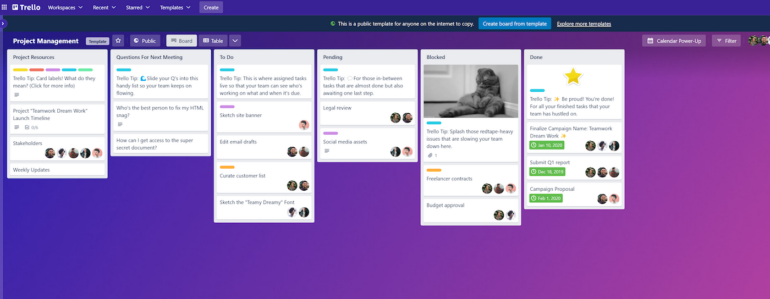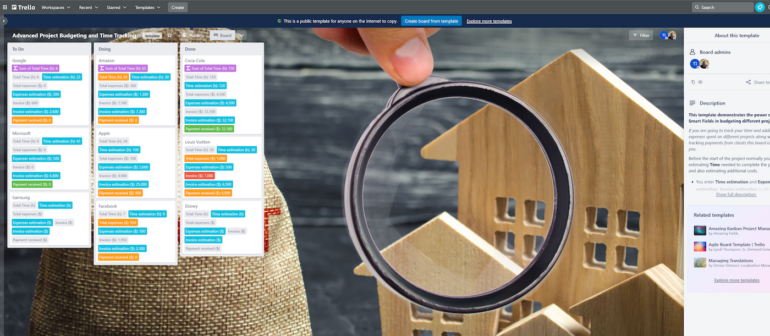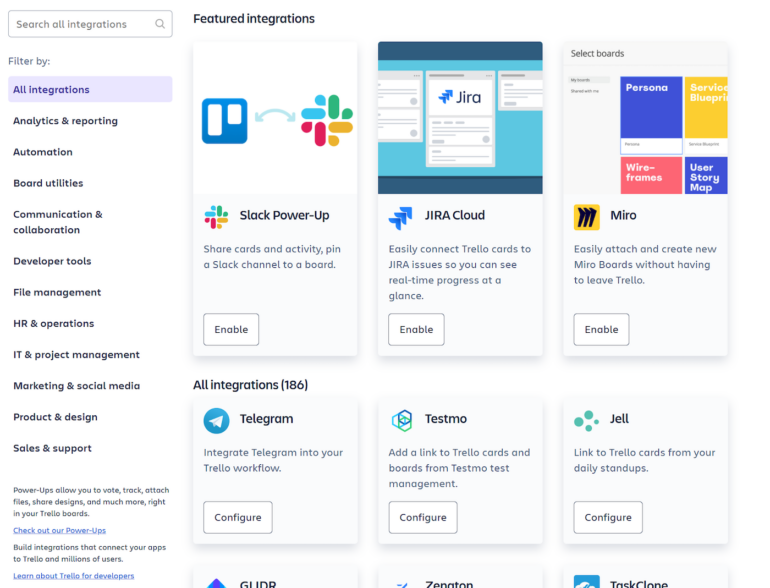Trello’s fast factsPricing: Free version available; paid plans start at $5 per user per month, billed annually. Key features:
|

Trello is a project management software solution that stands out for its user-friendly interface and powerful kanban board features. Its ease of use and straightforward pricing make Trello a popular choice for many teams. Trello’s built-in automation features further distinguish it from other competitors.
If your organization values a user-friendly platform with powerful kanban board features, Trello is worth considering. However, we have suggested a few alternatives should Trello not be ideal for you.
SEE: Looking for a project manager to lead your project teams?
Jump to:
- Pricing
- Key features of Trello
- Pros and cons
- Review methodology
- If Trello isn’t ideal for you, check out these alternatives
Pricing
Trello offers a free plan as well as three premium plans: Standard, Premium and Enterprise. In addition, Trello offers a 14-day free trial for its Premium plan.
Free
The free plan offers a variety of features that can meet the needs of individual users or small teams. However, Trello’s free plan has some limitations:
- Users are restricted to 10 boards per workspace.
- Users are limited to 250 Workspace command runs per month.
- File attachment size is capped at 10MB.
- Advanced features like priority support are not available.
Standard
Trello’s Standard plan costs $5 per user per month when billed annually and $6 per user per month when billed monthly. This plan offers good value for small teams, with added features such as unlimited storage, advanced checklists and custom fields.
Premium
Trello’s Premium plan costs $10 per user per month, billed annually and $12.50 per user per month, billed monthly. This plan targets teams that need to keep track of and visualize multiple projects, offering additional features like 24/5 support, views and admin controls.
Enterprise
Trello’s Enterprise plan targets large teams that require more security and controls. It costs $17.50 per user per month, billed annually, at $210 for a team of 50 users. You can calculate the estimated cost of the software for between 50 to 5,000 users on the Trello pricing page.
Organizations with more than 5,000 users would have to reach out to Trello’s sales team to obtain pricing information.
Key features of Trello
Highly visual and customizable kanban boards
Trello’s highly visual and customizable kanban boards are arguably the best among its competitors. These boards (Figure A) make it easy for teams to visualize their projects and progress, with drag-and-drop functionality that simplifies task management. Users can add labels, checklists and attachments to cards, ensuring all necessary information is easily accessible.
Figure A

Built-in automation features with Butler
Butler, Trello’s built-in automation tool, allows users to create rules, buttons and commands to automate repetitive tasks and streamline workflows. This feature saves time and reduces the potential for human error in task management.
Templates
Trello offers templates (Figure B) in the form of pre-designed board layouts that help users quickly set up and customize their projects according to their specific needs. These templates cover various use cases, such as product development, marketing and team collaboration.
With a plethora of uses, teams can easily adopt Trello and streamline their workflows. By using templates, users can save time and effort in organizing tasks and focus on the core aspects of their projects.
Figure B

Collaboration capabilities
Trello fosters collaboration through features such as comments, mentions and real-time updates. Team members can easily communicate and collaborate on tasks within the platform, ensuring everyone stays on the same page.
180+ integrations
Trello offers more than 180 integrations (Figure C) with popular tools such as Slack, Google Drive and GitHub. This makes it easy for teams to connect their existing tools and streamline their workflows. These integrations are split across categories such as analytics and reporting, automation, communication and collaboration and IT and project management among others.
Figure C

Pros and cons
| Pros | Cons |
|---|---|
|
|
If Trello isn’t ideal for you, check out these alternatives
As impressive as it is, Trello lacks the customizability and advanced capabilities of other alternatives. If you seek a project management tool with advanced project management features, extensive customization options, specialized views or more robust reporting and analytics capabilities, here are some alternatives to consider.
| Software | Trello | ClickUp | monday work management | Airtable |
|---|---|---|---|---|
| Intuitive kanban boards | Yes | Yes | Yes | Yes |
| Built-in automation | Yes | Yes | Yes | Yes |
| Built-in Agil project management | No | Yes | No | No |
| Real-time reporting | Yes | Yes | Yes | Yes |
| Ready-to-use templates | Yes | Yes | Yes | Yes |
| Free plan | Yes | Yes | Yes | Yes |
| Free trial | 14 days | 30 days | 14 days | 14 days |
| Pricing (per user per month) | Starts at $5 | Starts at $5 | Starts at $8 | Starts at $10 |
ClickUp

ClickUp is a highly customizable project management software with a wide array of features, including Agile project management, 15+ customizable views and real-time reporting. An organization might choose ClickUp over Trello for its advanced project management features and extensive no-code automation options.
ClickUp’s high customizability also makes it suitable for organizations that require extensive customization options at the expense of Trello’s limited capabilities and simplicity.
For a more in-depth look, check out our comparison of Trello and ClickUp.
monday work management

monday work management is a versatile and flexible project management tool that offers an all-in-one management solution for teams. Its highly visual nature makes it an excellent option for teams looking for a visually engaging project management platform.
An organization may prefer monday work management to Trello due to monday’s all-in-one approach to project management. This well-rounded approach makes monday suitable for many use cases and industries, making it an attractive choice for teams seeking a comprehensive and adaptable project management tool.
For a more in-depth look, check out our comparison of Trello and monday work management.
Airtable

Airtable is a project management tool designed for data-driven use cases. It provides ready-to-use project management templates, which can be a great option for teams looking to avoid a steep learning curve associated with tools with more complex capabilities like ClickUp.
A user might opt for Airtable over Trello if they require a project management tool geared toward data-driven use cases. Airtable’s spreadsheet-like interface, combined with database capabilities, makes it an excellent choice for organizing and managing large amounts of data.
For a more in-depth look, check out our comparison of Trello and Airtable.
Review methodology
We reviewed this project management software tool through hands-on experience with it to get a first-hand feel of Trello’s features and usability. Additionally, we examined official product documentation, Trello blogs, customer reviews, software review sites and more to enhance our review.
Who is Trello best for?
Trello project management is ideal for organizations looking for an easy-to-use and efficient project management tool that offers powerful kanban boards and collaboration features. It is suitable for businesses of all sizes and caters to teams that want an intuitive solution without a steep learning curve.
Trello is a great choice for:
- Teams of all sizes: Trello’s scalable features make it suitable for small teams, startups and large organizations alike. Its competitive pricing ensures Trello remains affordable even as teams grow.
- Users that seek simplicity and ease of use: Trello’s intuitive interface and straightforward kanban boards are perfect for those who want a project management tool that is easy to adopt and navigate.
- Teams that require collaboration features: Trello offers robust collaboration tools, including commenting, file attachment and team member tagging, making it ideal for teams that need effective communication and collaboration on projects.
- Businesses looking for automation: Trello enables users to streamline workflows by automating repetitive tasks, creating custom rules, buttons and commands.
- Organizations that need seamless integrations: Trello’s compatibility with over 180 popular tools and apps allows users to keep all of their work in one place and maintain efficient workflows.
However, organizations that require more advanced features or extensive customization options may want to consider alternative project management solutions. If you’re not sure that Trello is right for you but you like its functionality, you can check out these other top kanban project management software.








